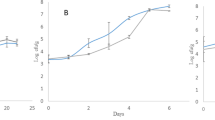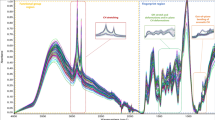Abstract
The aim of this research was to use the gas chromatography-mass spectrometry (GC/MS) profiling method coupled with chemometric tools to profile mechanically damaged and undamaged mushrooms during storage and to identify specific metabolites that may be used as markers of damage. Mushrooms grown under controlled conditions were bruise damaged by vibration to simulate damage during normal transportation. Three damage levels were evaluated; undamaged, damaged for 20 min and damaged for 40 min and two time levels studied; day zero and day one after storage at 4ºC. Applying this technique over 100 metabolites were identified, quantified and compiled in a library. Random forest classification models were used to predict damage in mushrooms producing models with error rates of >10% using cap and stipe tissue. Fatty acids were found to be the most important group of metabolites for predicting damage in mushrooms. PLS models were also developed producing models with low error rates. With a view to exploring biosynthetic links between metabolites, a pairwise correlation analysis was performed for all polar and non-polar metabolites. The appearance of high correlation between linoleic acid and pentadecanoic acid in the non-polar phase of damaged mushrooms indicated the switching on of a metabolic pathway when a mushroom is damaged.







Similar content being viewed by others
References
Arbona, V., Iglesias, D. J., Talón, M., & Gómez-Cadenas, A. (2009). Plant phenotype demarcation using nontargeted LC-MS and GC-MS metabolite profiling. Journal of Agricultural and Food Chemistry, 57(16), 7338–7347.
Breiman, L. (2001). Random Forests. Machine Learning, 45, 5–32.
Brosnan, J. T. (2003). Interorgan amino acid transport and its regulation. The Journal of Nutrition, 133, 2068–2072.
Burton, K. S. (2004). Cultural factors affecting mushroom quality—cause and control of bruising. Mushroom Science, 16, 397–402.
Chang, S. T., & Miles, P. G. (Eds.). (2004). Mushrooms: Cultivation, nutritional value, medicinal effect and environmental impact. Boston: CRC Press.
Dobson, G., Shepherd, T., Verrall, S. R., Conner, S., McNicol, J. W., Ramsay, G., et al. (2008). Phytochemical diversity in tubers of potato cultivars and landraces using GC/MS metabolomics approach. Journal of Agricultural and Food Chemistry, 56, 10280–10291.
Eastwood, D., & Burton, K. S. (2002). Mushrooms—a matter of choice and spoiling oneself. Microbiology Today, 29, 18–19.
Esquerre, C., Gowen, A. A., O’Donnell, C., & Downey, G. (2009). Initial studies on the quantitation of bruise damage and freshness in mushrooms using visible-near infrared spectroscopy. Journal of Agricultural and Food Chemistry, 57, 1903–1907.
Fiehn, O. (2008). Extending the breadth of metabolite profiling by gas chromatography coupled to mass spectrometry. TrAC Trends in Analytical Chemistry, 27(3), 261–269.
García-Cañas, V., Simó, C., León, C., & Cifuentes, A. (2010). Advances in Nutrigenomics research: Novel and future analytical approaches to investigate the biological activity of natural compounds and food functions. Journal of Pharmaceutical and Biomedical Analysis, 51(2), 290–304.
Gaston, E., Frias, J. M., Cullen, P. J., O’Donnell, C. P., & Gowen, A. A. (2010). Visible-near infrared hyperspectral imaging for the identification and discrimination of brown blotch disease on mushrooms (Agaricus bisporus) caps. Journal of Near Infrared Spectroscopy, 18(5), 341–353.
Gibney, M. J., Walsh, M., Brennan, L., Roche, H. M., German, B., & Ommen, B. (2005). Metabolomics in human nutrition: opportunities and challenges. The American Journal of Clinical Nutrition, 82, 497–503.
Gormley, T. R., & O’Sullivan, L. (1975). Use of a simple reflectometer to test mushroom quality. The Mushroom Journal, 34, 344–346.
Gowen, A. A., O’ Donnell, C. P., Taghizadeh, M., Cullen, P. J., Frias, J. M., & Downey, G. (2008a). Hyperspectral imaging combined with principal component analysis for bruise damage detection on white mushrooms (Agaricus bisporus). Journal of Chemometrics, 22(3–4), 259–267.
Gowen, A. A., O’Donnell, C. P., Taghizadeh, M., Gaston, E., O’Gorman, A., Cullen, P. J., et al. (2008b). Hyperspectral imaging for the investigation of quality deterioration in sliced mushrooms (Agaricus bisporus) during storage. Sensing and Instrumentation for Food Quality and Safety, 2(3), 133–143.
Gowen, A. A., Taghizadeh, M., & O’Donnell, C. P. (2009). Identification of mushrooms subjected to freeze damage using hyperspectral imaging. Journal of Food Engineering, 93(1), 7–12.
Jolivet, S., Arpin, N., Wichers, H. J., & Pellon, G. (1998). Agaricus bisporus browning: a review. Mycological Research, 102(12), 1459–1483.
Kuhn, M. (2008). Building predictive models in R using the caret package. Journal of Statistical Software, 28(5), 1–26.
Lin, X., Sun, L., Li, Y., Guo, Z., Li, Y., Zhong, K., et al. (2010). A random forest of combined features in the classification of cut tobacco based on gas chromatography fingerprinting. Talanta, 82, 1571–1575.
Lisec, J., Schauer, N., Kopka, J., Willmitzer, L., & Fernie, A. R. (2006). Gas chromatography mass spectrometry-based metabolite profiling in plants. Nature Protocols, 1, 387–396.
Lonchamp, L., Barry-Ryan, C., & Devereux, M. (2009). Identification of volatile quality markers of ready-to-use lettuce and cabbage. Food Research International, 42, 1077–1086.
Moalemiyan, M., Vikram, A., & Kushalappa, A. C. (2007). Detection and discrimination of two fungal diseases of mango (cv. Keitt) fruits based on volatile metabolite profiles using GC/MS. Postharvest Biology and Technology, 45(1), 117–125.
Moco, S., Forshed, J., De Vos, R. C. H., Bino, R. J., & Vervoort, J. (2008). Intra- and inter- metabolite correlation spectroscopy of tomato metabolomics data obtained by liquid chromatography-mass spectrometry and nuclear magnetic resonance. Metabolomics, 4(3), 202–215.
Mohapatra, D., Frias, J. M., Oliveira, F. A. R., Bira, Z. M., & Kerry, J. (2008). Development and validation of a model to predict enzymatic activity during storage of cultivated mushrooms (Agaricus bisporus spp.). Journal of Food Engineering, 86, 39–48.
Morcuende, R., Krapp, A., Hurry, V., & Stitt, M. (1998). Sucrose-feeding leads to increased rates of nitrate assimilation, increased rates of alpha-oxoglutarate synthesis, and increased synthesis of a wide spectrum of amino acids in tobacco leaves. Planta, 206, 394–409.
Needham, R., Williams, J., Beales, N., Voysey, P., & Magan, N. (2005). Early detection and differentiation of spoilage of bakery products. Sensors and Actuators B: Chemical, 106(1), 20–23.
Norli, H. R., Christiansen, A., & Holen, B. (2010). Independent evaluation of a commercial deconvolution reporting software for gas chromatogrpahy mass spectrometry analysis of pesticide residues in fruits and vegetables. Journal of Chromatography. A, 1217, 2056–2064.
O’Gorman, A., Downey, G., Gowen, A. A., Barry-Ryan, C., & Frias, J. M. (2010). Use of fourier transform infrared spectroscopy and chemometric data analysis to evaluate damage and age in mushrooms (Agaricus bisporus) grown in Ireland. Journal of Agricultural and Food Chemistry, 58(13), 7770–7776.
O’Hara, P., Slabas, A. R., & Fawcett, T. (2002). Fatty acid and lipid biosynthetic genes are expressed at constant molar ratios but different absolute levels during embryogenesis. Plant Physiology, 129, 310–320.
Pedreschi, R., Franck, C., Lammertyn, J., Erban, A., Kopka, J., Hertog, M. L. A. T. M., et al. (2009). Metabolic profiling of ‘Conference’ pears under low oxygen stress. Postharvest Biology and Technology, 51, 123–130.
R_Development_Core_Team (2009). R: a language and environment for ststistical computing. Vienna, Austria: R Foundation for Statistical Computing.
Roessner, U., Wagner, C., Kopka, J., Trethewey, R. N., & Willmitzer, L. (2000). Simultaneous analysis of metabolite in potato tuber by gas chromatography-mass spectrometry. The Plant Journal, 23(1), 131–142.
Roessner-Tunali, U., Hegemann, B., Lytovchenko, A., Carrari, F., Bruedigam, C., Granot, D., et al. (2003). Metabolic profiling of transgenic tomato plants overexpressing hexokinase reveals that the influence of hexose phosphorylation diminishes during fruit development. Plant Physiology, 133(1), 84–99.
Schauer, N., Zamir, D., & Fernie, A. R. (2005). Metabolic profiling of leaves and fruit of wild species tomato: a survey of the Solanum lycopersicum complex. Journal of Experimental Botany, 56(410), 297–307.
Steuer, R., Kurths, J., Fiehn, O., & Weckwerth, W. (2003). Observing and interpreting correlations in metabolomic networks. Bioinformatics, 19(8), 1019–1026.
Taghizadeh, M., Gowen, A., Ward, P., & O’ Donnell, C. P. (2010). Use of hyperspectral imaging for evaluation of the shelf-life of fresh white button mushrooms (Agaricus bisporus) stored in different packaging films. Innovative Food Science & Emerging Technologies, 11(3), 423–431.
Teagasc (2007). The Irish agricultue and food development authority. Teagasc Mushroom Newsletter 29.
Trenkamp, S., Eckes, P., Busch, M., & Fernie, A. R. (2009). Temporally resolved GC-MS-based metabolic profiling of herbicide treated plants treated reveals that changes in polar primary metabolites alone can distinguish herbicides of differing mode of action. Metabolomics, 5, 277–291.
Vikram, A., Prithiviraj, B., Hamzehzarghani, H., & Kushalappa, A. C. (2004). Volatile metabolite profiling to discriminate diseases of McIntosh apple inoculated with fungal pathogens. Journal of the Science of Food and Agriculture, 84(11), 1333–1340.
Zheng, L., Watson, D. G., Johnston, B. F., Clark, R. L., Edrada-Ebel, R., & Elseheri, W. (2009). A chemometric study of chromatograms of tea extracts by correlation optimization warping in conjunction with PCA, support vector machines and random forest data modeling. Analytica Chimica Acta, 642(1–2), 257–265.
Acknowledgments
Thanks are due to Dr. Helen Grogan and Ted Cormican, Teagasc, Kinsealy Research Centre (Dublin, Ireland), for the supply of mushrooms and background information. We acknowledge financial support from the Irish Department of Agriculture and Food under the Food Institutional Research Measure (FIRM), supported through EU and national funds.
Author information
Authors and Affiliations
Corresponding author
Rights and permissions
About this article
Cite this article
O’Gorman, A., Barry-Ryan, C. & Frias, J.M. Evaluation and identification of markers of damage in mushrooms (Agaricus bisporus) postharvest using a GC/MS metabolic profiling approach. Metabolomics 8, 120–132 (2012). https://doi.org/10.1007/s11306-011-0294-3
Received:
Accepted:
Published:
Issue Date:
DOI: https://doi.org/10.1007/s11306-011-0294-3




